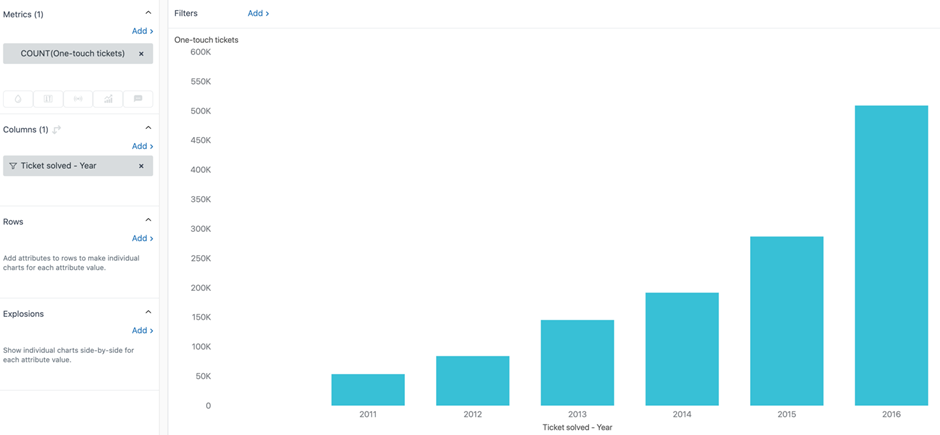As a business owner, you’re always looking for ways to increase efficiency and optimize your workflow. One area of your business that may not be getting the attention it deserves is customer service.
In this blog post, we’ll explore the importance of agent touches per ticket and show you how to optimize your customer service operations. By following these tips, you’ll be able to improve your customer satisfaction rates while reducing costs. Thanks for reading!
What is Agent Touches per Ticket?
Agent Touches per Ticket is a metric that helps companies measure how many times an agent has to contact a customer in order to resolve their issue. It not only helps identify how efficiently agents are working but also provides insights into how customers’ needs can be better satisfied.
The sooner agents contact customers, the sooner issues can be resolved and customers can get the help they need. By evaluating Agent Touches per Ticket, businesses can better understand how customer service interactions are going and take steps to optimize customer support for a faster resolution rate.
Why Is It Important For Startups To Track This Metric?
Tracking Agent Touches per Ticket is an important metric for startups because it helps them measure the efficiency of their customer support teams. By tracking this data, startups can identify areas of improvement in terms of response time, quality of service, and overall performance. This will ultimately help startups increase customer satisfaction and loyalty while reducing costs associated with providing customer support.
Additionally, tracking Agent Touches per Ticket can provide valuable insights into customer behavior and preferences, allowing startups to better tailor their services and products to meet their customers’ needs. Startups that take the time to track this data are more likely to be successful in a competitive marketplace. Ultimately, tracking Agent Touches per Ticket helps startups build stronger relationships with their customers and become better businesses.
How do you calculate Agent Touches per Ticket?
Here is the formula:
Total Number of Ticket Touches / Total Number of Resolved Tickets = Average Ticket Touches (mean)
If you want to calculate your Average Ticket Touches, you’ll need to divide the total number of replies on resolved conversations by the total number of resolved conversations with at least one reply. In other words, this metric helps you understand how many times an agent touches a ticket, on average, before it’s resolved.
This is useful information to have because it can help you see where bottlenecks are happening in your support process and identify opportunities for improvement. If you find that your Average Ticket Touch is too high, it could be an indication that your agents are taking too long to resolve tickets or that they aren’t following best practices for handling customer inquiries.
Either way, it’s important to dig into this metric and use it to inform your decisions about how to improve your support process.
What factors affect Agent Touches per Ticket?
Here are the factors that affect agent touches per ticket:
Ticket Volume
The level of ticket volume is the primary factor that affects agent touches per ticket. If you have a high number of tickets submitted, your agents may need to touch each ticket multiple times in order to complete the request.
Quality of Resolution
The quality of service your agents provide also has an impact on how many touches an agent needs to make to a ticket. Quality service means agents spend more time reviewing and addressing customer requests correctly the first time, which reduces the need for multiple touches.
Automation
Automated processes such as chatbots and AI can help reduce the number of agent touches per ticket by taking care of some of the basic tasks like gathering customer information and providing simple replies.
Knowledge Base
Having a comprehensive knowledge base with up-to-date information to help inform agents is another factor that can reduce the number of touches needed per ticket. By making good use of your knowledge base, agents will be able to quickly access relevant answers for customers, saving them time and effort.
Ticket Complexity
Finally, the complexity of each ticket plays a role in determining the number of agent touches per ticket. More complex tickets require more attention from agents and may need to be touched multiple times before being resolved.
By understanding these factors, you can improve your customer service delivery, reduce the number of agent touches per ticket, and create a better customer experience.
So when it comes to optimizing your team’s workflow, make sure you understand the factors that affect agent touches per ticket. With this knowledge, your team will be able to provide faster service while also improving overall customer satisfaction.
What are the effects of Agent Touches per Ticket on a startup
Here are the effects of agent touches per ticket on startup:
Improved Customer Satisfaction
Agent touches per ticket can help increase customer satisfaction by providing quick and efficient communication with customers. This helps to ensure that customer queries are quickly answered, which leads to improved overall satisfaction.
Increased Productivity
By reducing the number of agent touches per ticket, startups can reduce the amount of time spent on each ticket, thereby increasing productivity. This means that more customer issues can be resolved in less time and with better quality.
Cost Savings
With fewer agent touches per ticket, startups can save money by reducing the number of agents needed to handle customer queries and problems. By reducing the number of staff members required to manage incoming customer tickets, startups can cut costs and improve the bottom line.
Improved Efficiency
By reducing the amount of time it takes to resolve customer queries, startups can ensure that customers receive their issues resolved more quickly. This helps to reduce overhead costs tickets and can free up resources to be used on other areas of the business.
Improved Quality
With fewer agent and customer interactions, the quality of customer service can be improved. This leads to better customer satisfaction and higher overall sales.
Ultimately, agent touches per ticket can have a positive effect on a startup by improving productivity, reducing costs, and providing customers with high-quality customer service. With fewer agent touches per ticket, startups can save time and money, while providing their customers with an improved customer experience.
What are good Agent Touches per Ticket?
So, what is a good number of touches per ticket? Unfortunately, there is no easy answer to this question. It will vary depending on factors such as the nature of the issue and the product or service being offered. That said, most experts agree that somewhere between four and six touches per ticket are ideal. This gives agents enough time to fully understand the issue and provide a comprehensive resolution, without drawn-out or repetitive interactions.
Ultimately, striving for a high level of customer satisfaction should be every business’s goal. And while the number of agent touches per ticket is one important metric to keep an eye on, it’s not the only one. By taking a holistic approach and considering all aspects of the customer experience, businesses can ensure that they are providing the best possible service.
Analyzing tickets with low agent touches
For each ticket, Explore records how many agent responses were required to solve the issue. Tickets that are resolved with a single reply are classified as one-touch tickets, while those requiring two replies are known as two-touch tickets. Any tickets needing more than two agent comments to be solved fall under the multi-touch ticket category.
It’s important to note that if a ticket is reopened and another reply is added, the number of touches will increase. For example, a one-touch ticket may become a two-touch or even higher in the event of multiple reopenings.
Example
This example will show the number of one-touch tickets generated by agents, yearly.
- Create a new report in Explore using the Support: Tickets dataset.
- In the Metrics panel, choose the Agent replies distribution > One-touch tickets metric to count the total one-touch tickets created for your account.
- To divide these numbers by year, add Ticket solved – Year as an attribute in the Rows panel of your report.
- Your report will show a table with the number of one-touch tickets created each year.

Tips To Improve Agent Touches per Ticket
Here are tips to improve agent touches per ticket:
Streamline Ticket Handoffs
Make sure that when tickets are passed from one agent to another, there is clear communication about the status of the ticket and any important customer information. This will help ensure that each agent knows exactly what needs to be done with the ticket and can start working on it right away instead of having to spend time playing catch-up.
Anticipate and Prepare
Train your agents to anticipate customer needs and have all the necessary information prepared before they touch a ticket. This will significantly reduce the time spent on each ticket and help increase the overall productivity of the team.
Automation Where Possible
Automating parts of the process can save a lot of time, but make sure that it doesn’t come at the cost of quality customer service. Automation should be used to improve the efficiency of processes, not to replace agents altogether.
Monitor Performance
Keeping track of agent performance can help you identify areas where they need more training or support so that you can better optimize their workflow.
Stay Organized: Utilize customer relationship management (CRM) tools and task-tracking systems to help agents stay organized and quickly access the information they need. This will help them easily manage a large number of tickets and reduce their touches per ticket.
Set Clear Goals
Make sure that your agents understand what their goals are for each ticket, and make sure those goals are tied to overall customer satisfaction. This will ensure that the agents are focusing on providing the best possible service in the most efficient way.
Follow-up
Make sure your agents follow up with customers after resolving an issue to verify that they were happy with the service they received. This will help reduce the number of tickets that require multiple agent touches and improve customer satisfaction overall.
By following these tips, you can significantly reduce your agents’ touches per ticket and create a more efficient and productive customer service team.
Conclusion
It’s important to remember that every interaction is an opportunity to create a lasting impression—positive or negative. In the customer service industry, we know that one of the main ways to increase customer satisfaction and loyalty is by providing quality agent touches per ticket. If you can aim for six or more quality interactions with each customer throughout the life of their ticket, you’ll be on your way to creating lifelong fans of your company.

